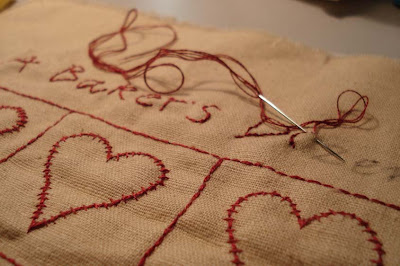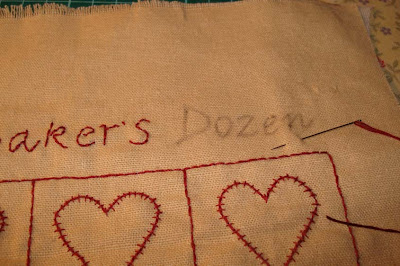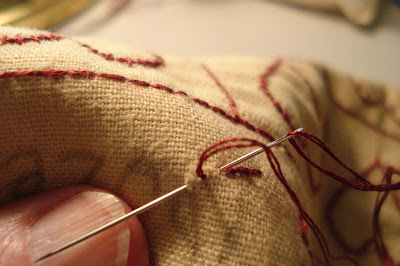I'm really pleased so many of you are interested in starting to stitch. It's a wonderful way to make beautiful gifts and it will help you create a 'uniquely you' home. These little stitcheries can decorate cushions, tote bags, quilts, aprons, dresses and cardigans as well as be made into wall hangings. They can be personalised by adding someone's name and you can add your favourite sayings by printing the text out at the right size from your computer and transferring that text to your fabric.
Stitchery is just a drawing on fabric that you colour by stitching the lines with coloured thread. If you're a good drawer, go ahead and freehand your pattern straight on to your fabric. If you need some help with design, there are some of my free patterns below that you can trace. Please modify them to suit your tastes too, I don't mind at all.
I have written about starting stitchery before, so please read this and be guided by the links for transferring designs onto fabric and how to do back stitch.
I have written about starting stitchery before, so please read this and be guided by the links for transferring designs onto fabric and how to do back stitch.
A fully equipped thread box will take a while to build up, but start with your favourite colours and slowly take it from there, adding new colours or different shades when you can afford them. Try to buy pure cotton or pure linen fabric. They are lovely to work with, sit nicely on other fabrics and will last a long time. If you're in Australia, I've recently found "handkerchief linen" at Spotlight. It's a very nice fabric and a half metre will do you nicely for a few projects. You will also need a backing for the fabric which helps anchor your stitches and gives a better finished result. If your local fabric shop doesn't stock this, you'll find it at your craft store.
When you choose your first piece of thread you'll notice the thread has six strands. You will only work with two strands at a time so you have to divide the thread, taking two strands for your work. You do this by cutting the required length of thread, don't make it too long, and then carefully pulling two threads away. Untwirl the main thread as you go.
When you choose your first piece of thread you'll notice the thread has six strands. You will only work with two strands at a time so you have to divide the thread, taking two strands for your work. You do this by cutting the required length of thread, don't make it too long, and then carefully pulling two threads away. Untwirl the main thread as you go.
The one stitch you'll use more than others is back stitch. Practise a few lines of back stitch before you start on your pattern. It's personal choice whether you use a hoop or not. I use one sometimes for smaller patterns, otherwise I just hold the fabric. Like everything else, this is about developing your own style and seeing how you work best with it. Learn the basics and then modify it to suit yourself.
Stitchery is a wonderful thing to do in summer or winter and it's very portable so you can take it with you when you go out. I hope you enjoy this very likeable past time. Like everything else in our lives, start slowly, buy the best quality fabric you can afford and be mindful of your work. People have been stitching for hundreds of years so with your stitchery you are joining the long tradition of handmade craft.
My patterns are here, here and here.
ADDITION: I've just found this wonderful embroidery tutorial on Purlbee.
If you know of any good free pattern sites, please share them with us.





